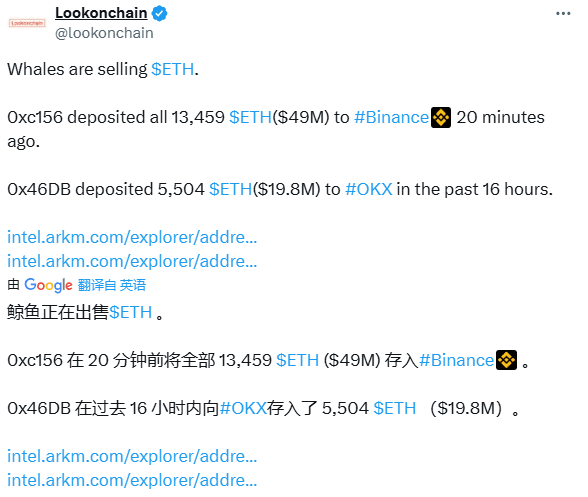Crypto friends, are you ready to face a storm? The latest news has struck like a deep-sea thunderclap: two whales have cumulatively transferred $68.8 million worth of ETH to CEX (centralized exchanges). This news detonated like a heavy bomb, instantly shaking the entire cryptocurrency market!

Whale movements are no coincidence, hiding significant market signals.
In the world of cryptocurrencies, whales have always been the forces that stir up the winds and clouds. These capital giants, holding hundreds of millions of dollars, operate on a logic that far exceeds retail investors' imagination—every on-chain movement is meticulously calculated, often hiding key signals capable of overturning the market. This synchronized action by the two whales, transferring massive amounts of ETH to centralized exchanges, undoubtedly sends a strong signal to the market: the cryptocurrency market is about to experience violent fluctuations.
Panic spreads like a plague; retail investors may become 'follower leek'.
This news is like throwing a giant stone into a calm lake, stirring up thousands of waves in the already sensitive cryptocurrency market. On-chain monitoring data shows that within 2 hours after the news broke, the fear and greed index plummeted by 12 percentage points, and social media platforms like Twitter and Telegram were filled with anxious discussions about 'whale dumping warnings.' Historical experience tells us that when ordinary investors see such a massive asset transfer, they are easily caught in collective panic. Once a vicious cycle of 'whale sell-off - retail follow - stampede out' forms, the cryptocurrency market might repeat the devastating scenes of the 2022 FTX collapse.
The supply-demand balance is severely tilted; ETH price may face heavy blows.
From the perspective of the economic supply-demand model, this transfer is reconstructing the market landscape of ETH. According to CoinGecko data, in just the past week, net inflows of ETH to centralized exchanges surged by 320%, reaching a near six-month peak. When a large volume of sell orders suddenly floods into exchange wallets while the market's absorption capacity has not yet been fully released, ETH's price will inevitably face enormous downward pressure. It is like the crude oil futures market suddenly encountering a strategic reserve sell-off, where short-term price pressure has become a foregone conclusion. If whales subsequently enter a selling mode, ETH may break through key support levels, triggering a larger-scale market upheaval.
History always tends to repeat itself; the lessons from the past are bloody.
Looking at the crisis archives of the cryptocurrency market, similar scenarios have played out multiple times. In May 2023, an anonymous whale transferred SOL worth $50 million to Coinbase, triggering a chain sell-off within just 48 hours, causing SOL's price to plummet 18% in one day, deeply trapping countless retail investors who chased the high. Even more alarming was the Luna collapse in 2021, which was triggered by whales selling off in advance, causing a domino effect. This time, the scale of the ETH transfer is larger and involves more parties; the market is holding its breath to see if history will repeat itself.
The chain reaction affects the entire market, and confidence in the cryptocurrency sector is severely impacted.
As the second-largest cryptocurrency by market capitalization, ETH's price fluctuations have never been isolated events. Its price changes directly affect the locked value in the DeFi ecosystem, the activity of Layer 2 networks, and even the liquidity of the entire cryptocurrency market. On-chain analysis platform Nansen's data shows that stablecoins USDT and DAI, which are highly correlated with ETH, have shown unusual movements. Popular projects based on Ethereum, such as SUI and ARB, have all seen a decline of over 5% in the last 24 hours. If ETH continues to face pressure, the investment confidence in the entire cryptocurrency market will be severely damaged, and the risk of capital flight will increase.
Whale intentions are a mystery, and the market is mired in high uncertainty.
Regarding the true intentions of the whales, market analysts are divided. Glassnode researchers speculate that it may be institutional investors rebalancing assets in preparation for the upcoming Bitcoin ETF trend; others on anonymous trading forums suggest that whales may be using market panic to accumulate positions. But what is certain is that this wave of operations has plunged the market into a 'fog mode', where every subsequent on-chain action could become the last straw that breaks the camel's back.
Retail survival guide: Calmness is the only umbrella.
In this undercurrent-filled cryptocurrency game, ordinary investors need to stay clear-headed. It is recommended to adopt the following strategies:
Keep a close eye on on-chain data: Follow whale wallet dynamics through platforms like Glassnode and Nansen.
Set stop-loss mechanisms: Establish protective stop-loss orders at key support levels to avoid emotional trading.
Diversify investment risks: Reduce the proportion of single asset holdings and allocate stablecoins to cope with volatility.
The script of the cryptocurrency market is always filled with uncertainties. Are these two whales the 'grim reapers' sounding the alarm for a bear market, or the 'prophets' brewing a bull market? Let us remain vigilant and wait for the market to reveal the final answer. Finally, let us keep an eye on the next moves of these two whales—will this storm pass quickly, or will it stir up a giant wave that changes the landscape of the cryptocurrency market? The answer may soon be revealed.
